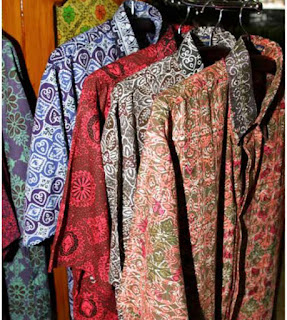while in fact, batik art had been existed in the province prior to the 17th century and disappeared along with the fall of Sultan Banten. Now with its fascination, batik Banten is began to rebirth. The efforts to revive batik Banten has been done by Banten Provincial Government through the Decree of the Governor of Banten in October 2003 regarding the establishment of the committee investigators of Batik Banten.
“Through the decree, motif assessment has been conducted, the results of the assessment motive then presented to the national archaeologists, humanist and Banten provincial government in September 2004,” said Uke Kurniawan, a former vice-chairman of the committee study of Batik Banten.
“Through the decree, motif assessment has been conducted, the results of the assessment motive then presented to the national archaeologists, humanist and Banten provincial government in September 2004,” said Uke Kurniawan, a former vice-chairman of the committee study of Batik Banten.
According to him, based on research, has found 75 ornaments of Batik Banten. The motif originated from the history and local wisdom of Banten’s people. “Batik Banten has its own identity and characteristics, some of motifs is adopted from artifacts of historical objects. Here’s the structure asset that characterized Batik Banten, “,he said. One of the fascination of Batik Banten is a pattern of datulaya. This motif has the basic rhombus-with flower and circles shapped inside figura leaf tendrils. The colors used are blue for basic motif, and gray for leaf tendrils figura on yellow-colored fabric. “Datulaya name is taken from the prince residence.
Datu means prince ad laya means shelter,” said Uke. By its characteristics, Batik Banten has now entered into international arena. This is reflected the awards earned in the meeting of archeology from 52 countries in Malaysia in the end of January 2005. “From Indonesia we bring the results of a study on the batik Banten and we got the best predicate. while datulaya motif signatured by The Minister of Home Affairs of Malaysia,” he said.
Uke added that In fact, Batik Banten is the first batik which have had a patent from the United Nations Educational, Scientific and Cultural Organization (UNESCO), a UN agency working in the field of Education, Scientific, and Cultural
In order to introduce batik Banten to wider community, Uke has ventured to plunge in the production of batik. This middle-aged man started his business in 2004 with a capital of USD 100 million. Then its developed after getting funding assistance from a number of State-Owned Enterprises (SOEs). Initially, Uke has only a dozens of employees. Now his employees numbering in hundreds. “At first the people was not enthusiastic, but as the development, people began wanting to learn to make batik Banten,” he said. He produces batik cap, printing, and tulis. “For batik tulis needs a longer time. Within two weeks it can only produce one batik,” he explained.
Although his business is still new, but public appreciation on his batik products is enormous. It is reflected by the support of Banten people and its surrounding communities . In addition, his production also has penetrated to international market. “Our buyers have reached Malaysia, Finland, Korea and several European countries,” he said. source : kina edisi khusus
Datu means prince ad laya means shelter,” said Uke. By its characteristics, Batik Banten has now entered into international arena. This is reflected the awards earned in the meeting of archeology from 52 countries in Malaysia in the end of January 2005. “From Indonesia we bring the results of a study on the batik Banten and we got the best predicate. while datulaya motif signatured by The Minister of Home Affairs of Malaysia,” he said.
Uke added that In fact, Batik Banten is the first batik which have had a patent from the United Nations Educational, Scientific and Cultural Organization (UNESCO), a UN agency working in the field of Education, Scientific, and Cultural
In order to introduce batik Banten to wider community, Uke has ventured to plunge in the production of batik. This middle-aged man started his business in 2004 with a capital of USD 100 million. Then its developed after getting funding assistance from a number of State-Owned Enterprises (SOEs). Initially, Uke has only a dozens of employees. Now his employees numbering in hundreds. “At first the people was not enthusiastic, but as the development, people began wanting to learn to make batik Banten,” he said. He produces batik cap, printing, and tulis. “For batik tulis needs a longer time. Within two weeks it can only produce one batik,” he explained.
Although his business is still new, but public appreciation on his batik products is enormous. It is reflected by the support of Banten people and its surrounding communities . In addition, his production also has penetrated to international market. “Our buyers have reached Malaysia, Finland, Korea and several European countries,” he said. source : kina edisi khusus











0 comments:
Post a Comment